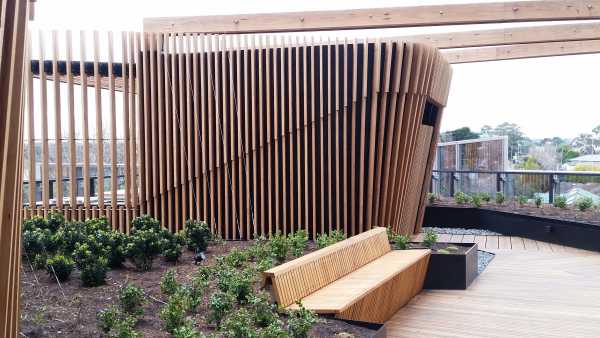Designed to thrive: creating a garden with the ‘ultimate renewable’
20 May 2021
Nicole Bittar
Communal gardens have been a shared entity since prehistoric times — at the aptly titled Fertile Crescent in the Neolithic period, to be specific. Yet their contemporary relevance continues to flourish.
It’s common knowledge that individual or shared gardens enhance health and wellbeing for their creators and the environment. DIY vegetable gardens not only reduce grocery bills and limit food mileage to your own backyard, but they are also a productive, stress-relieving exercise in accessing seasonal produce at its purest.
The same applies to the source material from which, for example, raised garden beds are created. And this is where sustainable timber, also known as the ultimate renewable, is a natural starting point when constructing your vegetable garden at home.
Raised garden beds or planters made from wood are designed to blend with nature and assist with soil aeration and drainage as opposed to concrete, stone, aluminium or other man-made materials. Bear in mind that a drip irrigation system also encourages plant growth and extends the life of your raised beds.

The look
Seek design inspiration for your raised garden beds in community produce gardens that have made headlines in sustainable practice. The rooftop vegetable garden for Acre Farmhouse Restaurant at the Burwood Brickworks shopping centre is a case in point — whereby the menu’s grown produce is sourced purely from the garden. It’s a contributing factor in the centre achieving Living Building Challenge certification as the world’s most sustainable shopping centre.
Community developer Nightingale Housing’s resident-shared ‘productive gardens’ are another prime example of how to create a vegetable garden partially constructed from the ‘ultimate renewable’ that’s designed to reap collective rewards.
Plan to succeed with your raised vegetable garden beds
Whether your DIY vegetable garden involves raised garden beds, raised planters or vegetable planter boxes, a family or neighbourhood project is easily achieved over one or two weekends.
Small-scale plant beds are the best approach, at least until you allow your hobby farm time to germinate.
First things first
Site selection and dimension come first, based on the raised bed not dominating your garden space and also what you intend to plant. Full sunlight is required for most vegetables, herbs and ornamentals.
Raised beds need not exceed 30cm in height for gardens to thrive. Make drainage checks a high priority, as soil that remains wet deprives plants of oxygen and can cause plant disease.
Once your design is finalised (gardening and hardware experts suggest that rectangular plots work best for construction and growing purposes), outline the perimeter using garden stakes and string. Then install the landscape timber edging. This provides the look for the raised vegetable bed, so ensure that the material is strong, durable and attractive. Decking screws that are galvanised to prevent rust are preferable to nails, which can split the wood. You will need an electric screwdriver to drive the screws into the post. Clamping the two together is recommended for a snug fit.
The good wood
Sleepers, Jarrah and Cypress Pine that has received ACQ or water-based wood preservation treatment and reclaimed timber are suitable source material. These are available from most hardware stores.
Bowens’ product specialist, Frank Di Stefano, recommends the use of these and other durable, hardwearing timbers, which are designed to withstand the elements. He says timber can be sorted into their natural durability classes. These range from Class 1, being the highest durability, to Class 4, being the lowest.
“Timber for raised garden beds with ‘in-ground’ contact should be either durability Class 1 or 2,” says Mr Di Stefano.
Ideal timber species include Ironbark (Class 1), Spotted Gum (Class 2), Cypress Pine (Class 2) and Red Gum (Class 2).
“These can be sourced as new, unseasoned sleepers or as recycled sleepers,” he says.
“Depending on the garden bed design, other sizes in these or similar timber species can be supplied.”
Mr Di Stefano also advises possible uses for low-durability species, such as Pine (Class 4), provided it receives the right treatment.
“Once it is preservative treated, its durability is increased,” he says. “The treatment also prevents termite attack and decay.”
Importantly, he says the level of treatment needs to be hazard-level 4 (H-4), which is suitable for in-ground use.
Equally so, the type of preservative treatment must be suitable for close human contact. In the case of Ecowood treated Pine sleepers and garden beds, these are treated with Tanalith E Wood Preservative to H-4.
Your local timber and hardware outlet offers construction and maintenance guidelines and advice.
Remember that many hands make light work. So, start small, keep it simple and involve friends or the neighbourhood on a reciprocal basis.
If DIY is not your style, you can also purchase portable, readymade timber garden beds. Depending on what and where you buy, prices start from around $20.
Once constructed and prior to planting, it’s important to see what grows in your neighbourhood and what are the main aims of your garden project (i.e. supplementary produce source or communal share arrangement?)
Building your own raised garden bed or planter box with sustainable timber is at one with nature and offers a homegrown feel. Inspiring the natural elements of floral colour and fragrance, inviting birdlife, butterflies, bright blooms and the freshest produce, which is bursting with flavour, will ultimately be its own reward.